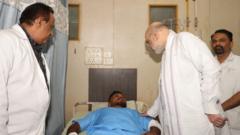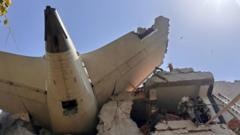In the aftermath of the recent Air India flight accident, which resulted in the loss of at least 270 lives, multiple perspectives reveal the complex human tragedy and the ongoing investigation into the cause of this devastating incident.
# Tragic Plane Crash in India: Investigative Pursuit Follows Catastrophe

# Tragic Plane Crash in India: Investigative Pursuit Follows Catastrophe
The Air India Flight 171 disaster reveals human and mechanical dimensions of a calamitous event, leaving families in mourning across the globe.
The ill-fated Air India Flight 171 took off from Ahmedabad on Thursday and, less than a minute later, crashed into a nearby medical college, resulting in a catastrophic explosion. Capt. Sumeet Sabharwal, 55, was contemplating retirement to support his elderly father, while his co-pilot, Clive Kunder, 32, was at the beginning of his career. Together, the pilots had amassed nearly 10,000 hours of flying experience, yet they faced an unimaginably tragic end.
As of Sunday morning, only 19 of those onboard had been identified. The sheer scale of the devastation meant that DNA testing was necessary to ascertain the identities of the deceased. Investigators have cordoned off the crash site and affected structures, recovering the flight data recorder, and now searching for the cockpit voice recorder. These crucial pieces of evidence will provide insights into the final moments of the flight and potentially elucidate whether the crash was caused by mechanical failure, human error, or a combination of both.
Despite the technical inquiries, experts agree that the pilots had little to no time to rectify the situation once the aircraft began its descent. The psychological impact of this loss is profound for families of the victims, particularly the Gujarati community in the UK, who are mourning their loved ones as they piece together a narrative out of collective heartbreak.
This tragic incident not only serves as a reminder of the fragility of life but also highlights the ongoing need for comprehensive investigations to prevent future disasters in aviation.
As of Sunday morning, only 19 of those onboard had been identified. The sheer scale of the devastation meant that DNA testing was necessary to ascertain the identities of the deceased. Investigators have cordoned off the crash site and affected structures, recovering the flight data recorder, and now searching for the cockpit voice recorder. These crucial pieces of evidence will provide insights into the final moments of the flight and potentially elucidate whether the crash was caused by mechanical failure, human error, or a combination of both.
Despite the technical inquiries, experts agree that the pilots had little to no time to rectify the situation once the aircraft began its descent. The psychological impact of this loss is profound for families of the victims, particularly the Gujarati community in the UK, who are mourning their loved ones as they piece together a narrative out of collective heartbreak.
This tragic incident not only serves as a reminder of the fragility of life but also highlights the ongoing need for comprehensive investigations to prevent future disasters in aviation.




















